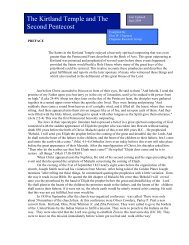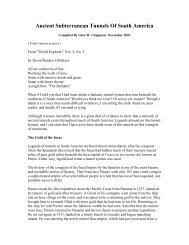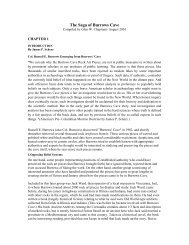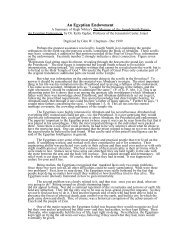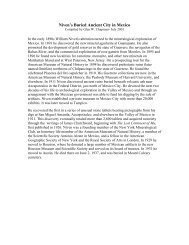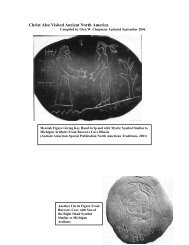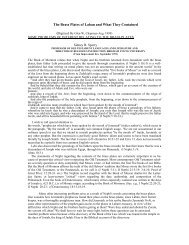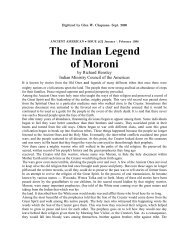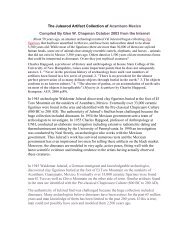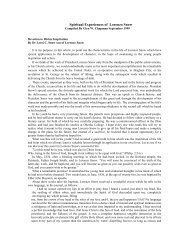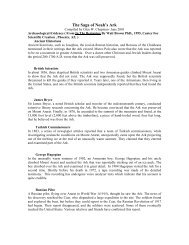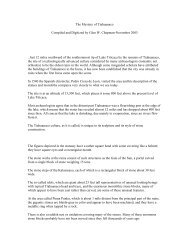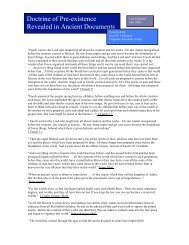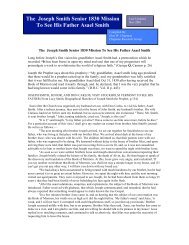Book of Mormon Evidences From Ancient Aztec and Mayan Writings
Book of Mormon Evidences From Ancient Aztec and Mayan Writings
Book of Mormon Evidences From Ancient Aztec and Mayan Writings
Create successful ePaper yourself
Turn your PDF publications into a flip-book with our unique Google optimized e-Paper software.
* Torquemada ... "It is true that the Indians <strong>of</strong> <strong>of</strong> the Isl<strong>and</strong> <strong>of</strong> Cuba say that they knew that theheaven <strong>and</strong> other things had been created; <strong>and</strong> they affirm by three persons, one <strong>of</strong> whom camefrom such a part, <strong>and</strong> the other two from other parts; <strong>and</strong> that they were perfectly informed also <strong>of</strong>the deluge, <strong>and</strong> that the world had been destroyed by a quantity <strong>of</strong> water. The old men aboveseventy <strong>and</strong> eighty years <strong>of</strong> age reported, when first our countrymen settled in that isl<strong>and</strong>, that anold man knowing that the deluge was about to happen, built a large ship, in which he embarkedwith his household <strong>and</strong> many animals, <strong>and</strong> that he dispatched from thence a crow, which did notreturn, staying to prey upon the dead caucuses; <strong>and</strong> that afterwards sent a dove; which came backcooing, bringing a leafy branch which resembled a hop, although not one: on which he quitted theship, <strong>and</strong> made wine <strong>of</strong> mountain grapes <strong>and</strong> became drunk ... VI 393* M. de Humboldt says that "The people <strong>of</strong> Mechoacan preserved a tradition, according to whichCoxcox, whom they named Tezpi, embarked in a large acalli, (a word compounded <strong>of</strong> atl watwr,<strong>and</strong> calli a house) with his wife, his children, <strong>and</strong> animals <strong>and</strong> seeds <strong>of</strong> various kinds, thepreservation <strong>of</strong> which was valuable to mankind. As soon as the great spirit Tezcatlipocacomm<strong>and</strong>ed the waters to retire, Tezpi caused a vulture, the Zopilote, (Vultur aurea) to leave thebark. This bird, whose food is carrion, did not return, on account <strong>of</strong> the number <strong>of</strong> dead bodies withwhich the earth only just was strewed. Tezpi sent other birds, <strong>of</strong> which the Colibri (or hummingbird)alone returned, bearing in its bill the leafy branch <strong>of</strong> a tree. Tezpi then perceiving that theearth began to be covered with new verdune, quitted his ark near the mountain <strong>of</strong> Colhuacan." VI117Funeral Rites <strong>and</strong> Imponderables* In reasoning on the probality <strong>of</strong> the Indians being descended from the Jews, from a strikingresemblance in their mourning ceremonies <strong>and</strong> funeral rites, the reflection naturally presents itselfto the mind, that all mankind are subject to the same feelings <strong>of</strong> grief for the loss <strong>of</strong> those dear tothem, so the mode <strong>of</strong> expressing those feelings is among all nations nearly the same, except wherethe custom has produced a change. When, therefore, we find the Indians <strong>and</strong> Jews differed from allother nations in their manner <strong>of</strong> mourning for the dead, <strong>and</strong> agreed with each other in manyarbitrary rites, such as in burning a portion <strong>of</strong> their household goods, in anointing their bodies withoil, in burning them amidst the loud lamentations <strong>of</strong> women hired as mourners, in celebratingfuneral feasts, in depositing great wealth in their tombs, in mourning for a stated period <strong>of</strong> timeafter the decease, in gathering their bones to those <strong>of</strong> their fathers, <strong>and</strong>, lastly, in employing thesame personal demonstrations <strong>of</strong> grief, such as falling on their face on the ground, <strong>and</strong> lying in thatposition sometimes for three days, placing their h<strong>and</strong>s upon their mouths, humiliating themselvesin the dust, blackening their faces with ashes <strong>of</strong> charcoal, lying in ashes, uttering the ejaculation,Ah, brother! <strong>and</strong> amongst other Indian tribes, rending the garments, cutting the flesh, <strong>and</strong> <strong>of</strong>t thehair, both which latter customs, though strictly forbidden to the Jews ... were commonly practised... VIII 388 Supplement* The curious analogy in the customs <strong>of</strong> the ancient Jews <strong>and</strong> the Peruvians will more fully appearfrom a comparison <strong>of</strong> the following passage from the ninth chapter <strong>of</strong> Balboa's inedited,'Miscellanea Antarctica', descriptive <strong>of</strong> the grief <strong>of</strong> Mango Capoc for the death <strong>of</strong> his brotherAyarcache, with the thirtieth verse <strong>of</strong> the thirteenth chapter <strong>of</strong> the first book <strong>of</strong> Kings, <strong>and</strong> theeighteenth verse <strong>of</strong> the twenty-second chapter <strong>of</strong> Jeremiah, from which it is evident that it was aHebrew custom to utter the ejaculation "Ah, my brother!" or, "Ah, sister!" at funerals:I compliance with the request <strong>of</strong> their brother Ayarcache, they repeatedly invoked his name <strong>and</strong>bewailed his loss: Ah, my brother! ...VIII 200, 201



